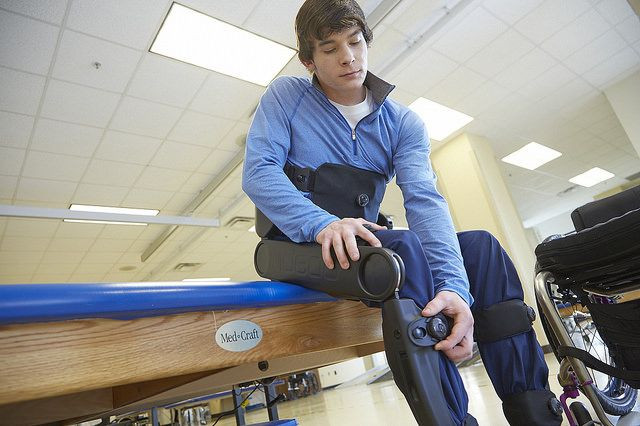Parker Hannifin Gets FDA Approval For Indego Exoskelton Designed To Help People With Spinal Cord Injury

The future may already be here for people suffering from lower limb paralysis, or paraplegia.
This past Thursday, March 10, the Food and Drug Administration (FDA) approved the Indego, a powered exoskeleton that grants users the ability to stand and walk on a variety of surfaces, for clinical and personal use. The clearance will allow Indego’s manufacturer, Parker Hannifin Corporation, to commercially launch the product in the United States in the near future. Though this marks the second such exoskeleton approved for home use by the FDA, after the ReWalk Personal Exoskeleton in 2014, the Indego is reportedly lighter, at 26 pounds, and easier to wear. The Indego had already received similar approval from the European Economic Area last November.
“For individuals who sustain spinal cord injuries, this is a milestone that could have a meaningful impact on their lives,” said Tom Williams, chairman and CEO of Parker Hannifin, in a statement announcing the approval. “In a relatively short amount of time, we have taken what was a prototype device and readied it for full commercial launch. We are excited about the future for this new growth opportunity.”
As reported by Brakeworks, the Indego was the initial brainchild of the Center for Intelligent Mechatronics at Vanderbilt University, specifically under the leadership of Dr. Michael Goldfarb, a Professor of Mechanical Engineering at the university. “It is particularly gratifying because it is the first thing that has come out of my lab that has become a product that people can purchase, which hopefully will make a significant improvement in their quality of life,” Goldfarb told Brakeworks.
In 2012 the then-called Vanderbilt Exoskeleton was licensed by Parker Hamilton. During the next three years, they went to work adapting it for the greater public, which involved an extensive clinical trial — purportedly the largest of its kind.
“In sponsoring such a comprehensive and landmark study, Parker demonstrated the safety and performance of the Indego technology,” said Dr. Gary Ulicny, president and CEO of Shepherd Center, a private, not-for-profit hospital in Atlanta, GA, specializing in spinal cord & brain injury rehabilitation that has also served as Parker’s lead clinical partner. “Over the course of more than 1,200 individual sessions, study participants were able to use Indego to safely walk on a variety of indoor and outdoor surfaces and settings with no serious adverse events.”
The exoskeleton works like a “legged segway,” allowing the user to begin motion by leaning forward, often with the use of crutches or a walker to stabilize themselves. When the user wants to sit back down into their wheelchair, they simply lean backwards.
Indego also features a hybrid system of functional electrical stimulation (FES), a technique that sends electrical currents to the muscle nerves of users. In people with partial paralysis, FES can restore a degree of control, letting patients contract and relax their muscles as they once did. In the Indego, the FES allows an user to help themselves move with the exoskeleton, reducing the amount of battery power needed to run the device and promoting better muscle strength.
Remarkable as the Indego and similar devices are, they aren’t yet permanent solutions. Neither the ReWalk nor the Indego can operate on stairs (a version of the ReWalk is cleared for descending down stairs, but not in the U.S.), and the Indego only has a battery power of four hours at most, though it does reportedly come with fast-charging batteries. Its cost, $80,000, is also particularly exorbitant. In the latter case, the company is intent on ensuring that the Indego can be at least partially covered by health insurance providers as an approved medical device. For those wondering, there are indeed other less-costly exoskeletons soon to be on the market.
Last fall, Parker also announced that it would team up with the U.S. Department of Defense to conduct a four-year-long study of the Indego and its potential health and economic benefits. The devices would be used by patients attending one of three rehabilitation centers, including the James Haley Veteran’s Hospital in Tampa, FL.
Published by Medicaldaily.com



























